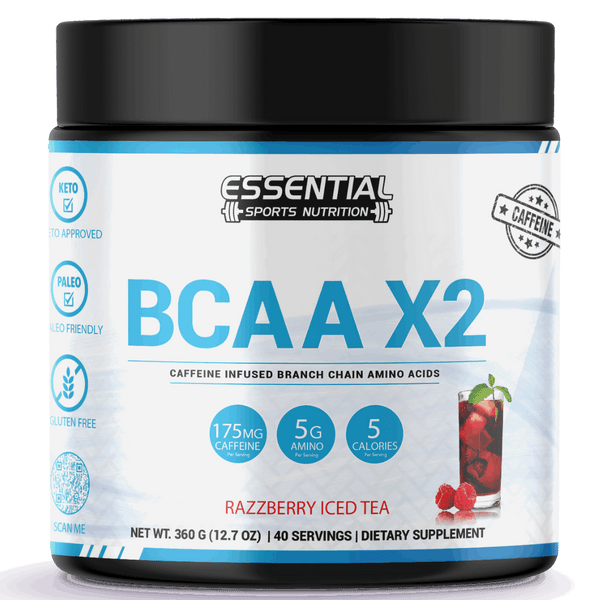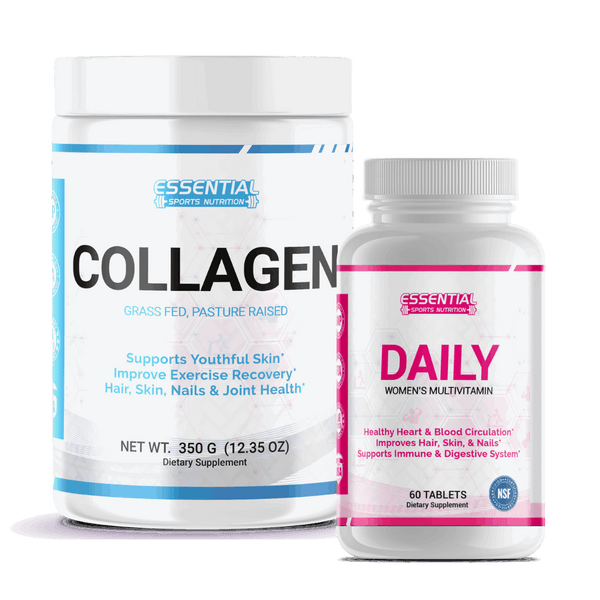How to Use and Take Creatine for Muscle Growth
To harness creatine's complete potential, initiate with a loading phase, consuming 20 grams per day for 5-7 days, divided into four 5-gram servings. Following that, transition to a maintenance dose of 3-5 grams daily. Taking creatine with a carb or protein-based meal is vital to enhance uptake and consider timing it post-workout for improved absorption. Remember, consistency is key for reaping creatine's muscle growth and strength benefits. Consider cycling through 8-week periods of supplementation followed by 2-week breaks to maintain natural production. Managing potential side effects like bloating by staying hydrated could make your experience smoother. With the right approach, you'll uncover creatine's complete potential.

Key Takeaways
-
Start with a loading phase of 20 grams per day, divided into four 5-gram servings, for 5-7 days.
-
Transition to a maintenance dose of 3-5 grams per day for long-term benefits.
-
Take creatine post-workout or with a carb- or protein-based meal to enhance absorption.
-
Consider cycling creatine by supplementing for 8 weeks followed by a 2-week break.
-
To minimize side effects, stay hydrated and consider taking creatine with a meal or using a micronized form.
Understanding Creatine Supplement Benefits

Supplementing with creatine can greatly enhance your muscle growth, strength, and overall exercise performance by boosting phosphocreatine stores in your muscles. This increase in phosphocreatine allows for more ATP production, which is essential for prolonged muscular strength and endurance during your workouts. By incorporating creatine into your regimen, you're not just investing in a supplement; you're accessing a higher level of performance and accelerated muscle mass gains.
Studies have consistently shown that creatine stands out among supplements for its significant benefits in increasing muscle mass and strength. It's not just for elite athletes or bodybuilders; anyone looking to improve their physical performance can benefit from creatine. The beauty of creatine lies in its simplicity and effectiveness. It's one of the safest and most well-researched supplements available today, giving you peace of mind alongside its muscle and strength-enhancing effects.
Optimal Creatine Dosage

When determining how much creatine to take, it's crucial to recognize that the ideal daily dosage typically ranges between 3-5 grams for most individuals. This range has consistently been shown to maximize the effects on body mass and strength gains, especially when combined with high-intensity exercise. Beginning with a loading phase of 20 grams per day for 5-7 days can assist in saturating your muscle stores more rapidly, setting the stage for peak performance enhancements.
Splitting the daily dose into four 5-gram servings during the loading phase improves absorption and utilization, ensuring that your body can effectively process and store creatine. Following this initial period, maintaining a long-term routine of 3-5 grams of creatine per day helps sustain these advantages without the need to cycle off the supplement. Additionally, it's beneficial to consume your creatine with a carb or protein-based meal, as this can enhance uptake into the muscles, making your supplementation even more effective.
Best Times for Creatine Intake

How do you determine the most effective time to take creatine for maximum absorption and performance benefits? While creatine can be taken at any time of the day, ensuring consistency is key. However, for the best results, consider the nuances of your daily routine and workout schedule.
Some studies suggest that taking creatine post-workout might offer enhanced absorption and benefits, particularly when your muscles are primed for recovery. Mixing your creatine with a carb- or protein-based meal can further enhance its uptake, making post-workout an opportune time for those looking to maximize efficiency.
Dividing your creatine dosage into smaller servings throughout the day, typically recommended at 3-5 g per day, may improve absorption without needing a loading phase. This strategy can be especially beneficial if you're avoiding the rapid saturation that comes from creatine loading, which generally involves taking higher doses of up to 20 g per day, divided into four servings for 5-7 days.
Personal preference and convenience also play a significant role. If dividing your dosage or timing it with meals and workouts feels overwhelming, choosing a consistent time that fits your schedule can still yield benefits. Whether it's with breakfast or post-workout, the best time to take creatine ultimately aligns with your lifestyle and goals.
Creatine Cycling Explained

In order to optimize your body's creatine levels and enhance athletic performance, it is important to understand the process of creatine cycling, which involves supplementing for 8 weeks, followed by a 2-week break. This structured approach begins with a loading phase, where higher doses of creatine are taken to quickly raise your body's creatine levels. After this initial phase, you'll shift to a maintenance phase, where lower daily doses are sufficient to sustain those elevated levels.
Implementing planned breaks after every 8-week cycle is key. These 2-week intervals without supplementation support your body's natural production of creatine, ensuring you don't become overly reliant on external sources. By cycling creatine in this manner, you maintain your body's responsiveness to supplementation, which is essential for optimal performance. Regular cycling also helps prevent potential down-regulation of your body's natural creatine production.
Managing Creatine Side Effects

To effectively manage the mild side effects linked with creatine use, it is important to stay informed and take practical steps towards mitigation. Gastrointestinal issues, such as nausea, stomach upset, and diarrhea, are common but can often be minimized by taking creatine with a meal or using a micronized form that's easier on the stomach. Temporary weight gain and bloating are also typical as muscles retain water, yet this is usually a sign that the creatine is working as intended. Despite myths, research has debunked the association between creatine and dehydration or heat-related illnesses, so don't let these concerns deter you.
It's comforting to know that creatine is safe for long-term use, with studies supporting its use at doses of up to 30g per day for several years without significant adverse effects. However, rare side effects like muscle cramps can occur. If you're among the few who experience this, consider adjusting your dosage or hydration strategy. Remember, creatine is well-tolerated by most individuals, and by staying informed and attentive to your body's responses, you can maximize its benefits while minimizing any discomfort.

Conclusion
So, you've got the lowdown on maximizing creatine's punch. Remember, getting the dosage just right and timing your intake can really make or break your gains. Don't forget that cycling through it can help keep your body responsive. Sure, side effects might throw a wrench in the works, but with smart management, they don't have to derail your progress. Stick with the evidence, listen to your body, and you'll be setting the stage for some serious strength and muscle growth.
How to Take Creatine for Muscle Growth FAQs
Q: How does creatine work for muscle growth?
A: Creatine helps increase the amount of creatine phosphate stored in muscle cells, which enhances the ability to produce energy during high-intensity exercise. This can lead to greater muscle mass and improved performance.
Q: What is creatine monohydrate and how should I take it?
A: Creatine monohydrate is the most common form of creatine used in supplements. It is usually taken in doses of around 5 grams per day, either before or after a workout, to support muscle growth and performance.
Q: Are there any side effects associated with creatine supplementation?
A: While creatine is generally considered safe for most people when taken within recommended doses, some individuals may experience side effects such as stomach discomfort, muscle cramping, or dehydration. It is important to stay hydrated while using creatine.
Q: What is the creatine loading phase and do I need to do it?
A: The creatine loading phase involves taking higher doses of creatine for a short period to saturate muscle stores more quickly. While it may help some individuals see faster results, it is not necessary for everyone and a maintenance dose of 3-5 grams per day can also be effective over time.
Q: Can I take creatine and caffeine?
A: Some research suggests that caffeine may reduce the effectiveness of creatine supplementation, particularly during the loading phase. It is recommended to space out the intake of creatine and caffeine to maximize the benefits of each substance.
Q: What are the supplementing benefits of creatine?
A: Creatine supplementation has been linked to increased muscle mass, improved strength, enhanced exercise performance, and faster recovery. It can be particularly beneficial for individuals engaged in high-intensity exercise or resistance training.
Q: Is there any research on the effects of creatine supplementation?
A: The International Society of Sports Nutrition supports the use of creatine as a safe and effective supplement for athletes looking to enhance performance. Numerous studies have shown positive results in terms of muscle growth, strength gains, and exercise capacity with creatine supplementation.
Q: How to Properly Take Creatine?
A: To properly take creatine, start with a 20g/day loading phase for 5–7 days, then maintain with 3–5g daily. Divide doses, take with meals for better absorption, and continue long-term without cycling for best results.
Q: Should You Take Creatine Every Day?
A: Yes, you should absolutely take creatine every day, unless you're aiming for less ideal results like a half-baked cake. Consistent use boosts exercise performance and muscle gains by ensuring steady phosphocreatine supply. Don't skip doses!
Q: Is It Best to Take Creatine Before or After a Workout?
A: It doesn't really matter if you take creatine before or after your workout. What's important is that you're consistent with your daily intake to make sure your muscles are fully saturated for best benefits.
Q: What Not to Do While Taking Creatine?
A: While taking creatine, don't exceed the 3-5 grams daily limit or skip the loading phase. Avoid acidic drinks like orange juice, don't neglect a balanced diet and hydration, and consult a doctor if you've health issues.




























